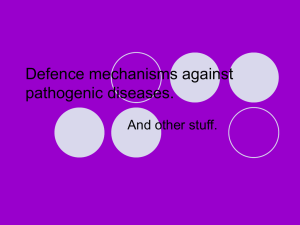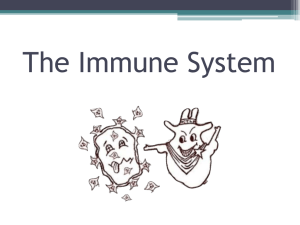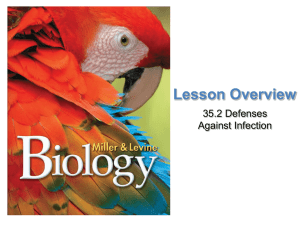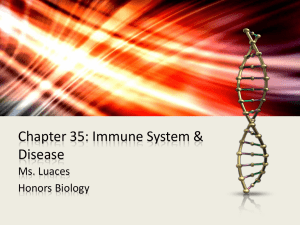35-2 Defense Against Infection PowerPoint
advertisement
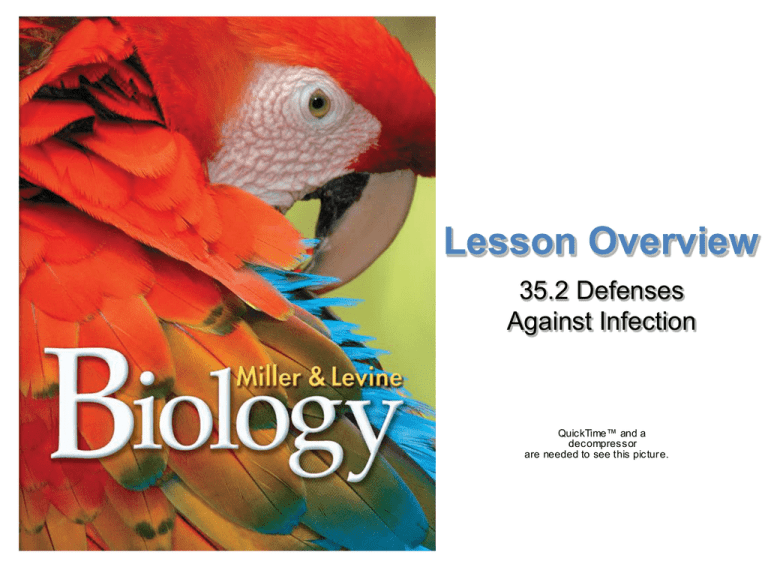
Lesson Overview Defenses Against Infection Lesson Overview 35.2 Defenses Against Infection QuickTime™ and a decompressor are needed to see this picture. Lesson Overview Defenses Against Infection Koch’s Postulates Koch’s studies with bacteria led him to develop rules for identifying the microorganism that causes a specific disease. These rules are known as Koch’s postulates. Although there are exceptions to these rules, they remain important guidelines for identifying the causes of new and emerging diseases. QuickT ime™ and a decompressor are needed to see thi s pi cture. Lesson Overview Defenses Against Infection QuickTime™ and a decompressor are needed to see this picture. Lesson Overview Defenses Against Infection Symbionts vs. Pathogens Symbionts=Good Guys Yeast and bacteria grow in the mouth and throat without causing trouble. Bacteria in the large intestine help with digestion and produce vitamins. Picture on next page shows light organ with bacteria in octopus Pathogens=Bad guys Some viruses and bacteria directly destroy the cells of their host. Other bacteria and single-celled parasites release poisons that kill the host’s cells or interfere with their normal functions. Parasitic worms may block blood flow through blood vessels or organs, take up the host’s nutrients, or disrupt other body functions Lesson Overview Defenses Against Infection QuickTime™ and a decompressor are needed to see this picture. QuickTime™ and a decompressor are needed to see this picture. Lesson Overview Defenses Against Infection THINK ABOUT IT With pathogens all around us, it might seem amazing that most of us aren’t sick most of the time. Why are we usually free from infections, and why do we usually recover from pathogens that do infect us? One reason is that our bodies have an incredibly powerful and adaptable series of defenses that protect us against a wide range of pathogens. QuickTime™ and a decompressor are needed to see this picture. Qui ckT ime™ and a dec ompress or are needed to s ee this pic ture. Lesson Overview Defenses Against Infection Nonspecific Defenses The body’s first defense against pathogens is a combination of physical and chemical barriers. skin tears secretions QuickTime™ and a inflammatory response decompressor are needed to see this picture. interferons fever These barriers are called nonspecific defenses because they act against a wide range of pathogens. Lesson Overview Defenses Against Infection First Line of Defense The most widespread nonspecific defense is the skin. Very few pathogens can penetrate the layers of dead cells that form the skin’s surface. QuickTime™ and a decompressor are needed to see this picture. QuickTime™ and a decompressor are needed to see this picture. Lesson Overview Defenses Against Infection First Line of Defense Other defenses protect parts of the body not covered by skin 1.) mouth 2.) nose 3.) eyes Saliva, mucus, & tears contain lysozymes that breaks down bacterial cell walls. Mucus in your nose and throat traps pathogens. cilia push the mucous-trapped pathogens away from your lungs. Stomach secretions destroy many pathogens that are swallowed. QuickTime™ and a decompressor are needed to see this picture. QuickTime™ and a decompressor are needed to see this picture. QuickTime™ and a decompressor are needed to see this picture. Lesson Overview Defenses Against Infection Second Line of Defense If pathogens make it into the body, through a cut in the skin, the body’s second line of defense swings into action. These mechanisms include – inflammatory response – interferons – fever QuickTime™ and a decompressor are needed to see this picture. QuickTime™ and a decompressor are needed to see this picture. Lesson Overview Defenses Against Infection Inflammatory Response The inflammatory response causes infected areas to become red, painful, and inflamed. Pathogens stimulate cells called mast cells to release chemicals histamines. Histamines increase the flow of blood and fluids to the affected area. Lesson Overview Defenses Against Infection Inflammatory Response Fluid leaking from expanded blood vessels causes the area to swell. White blood cells move from blood vessels into infected tissues. Lesson Overview Defenses Against Infection Inflammatory Response Many of the white blood cells (phagocytes) engulf & destroy bacteria. All this activity may cause a local rise in temperature. That’s why a wounded area sometimes feels warm. Lesson Overview Defenses Against Infection Interferons Viruses infect body cells, host cells produce proteins. These proteins help block viral replication. Interferons are proteins that “interfere” with viral growth. Interferons slow down the progress of infection & “buy time” for immune defenses to respond. QuickTime™ and a decompressor are needed to see this picture. Lesson Overview Defenses Against Infection Fever The immune system also releases chemicals that increase body temperature, producing a fever. The increased body temperature may stop the growth of some pathogens. Higher body temperature also speeds up parts of the immune response. QuickTime™ and a decompressor are needed to see this picture. QuickTime™ and a decompressor are needed to see this picture. Lesson Overview Defenses Against Infection Nonspecific Defenses What are the body’s nonspecific defenses against pathogens? Lesson Overview Defenses Against Infection Nonspecific Defenses What are the body’s nonspecific defenses against pathogens? Nonspecific defenses include the skin, tears and other secretions, The inflammatory response, interferons, and fever. QuickTime™ and a decompressor are needed to see this picture. Lesson Overview Defenses Against Infection Recognizing “Self” A healthy immune system recognizes all cells & proteins that belong in the body as “self.” Recognizing “self” is essential. The immune system controls powerful cellular and chemical weapons that could cause problems if turned against the body’s own cells. QuickTime™ and a decompressor are needed to see this picture. Lesson Overview Defenses Against Infection Recognizing “Nonself” – The immune system recognizes foreign organisms as “nonself.” – Once the immune system recognizes “others,” it attacks – After encountering a specific invader, the immune system “remembers” the invader – This recognition, response, and memory -the immune response. QuickTime™ and a decompressor are needed to see this picture. Lesson Overview Defenses Against Infection Antigens – Antigen (Bad Guy) -a foreign substance that can stimulate an immune response. – Antigens are located on surfaces of bacteria, viruses, or parasites. – Immune system responds by making cells that attack the invaders or produce proteins – antibodies (Good Guy) QuickTime™ and a decompressor are needed to see this picture. Lesson Overview Defenses Against Infection Antigens 1. Antibodies (good guy) tags antigens (bad guy) for destruction 2. The body makes up to 10 billion different antibodies. 3. The shape of each type of antibody allows it to attach to one specific antigen. Lesson Overview Defenses Against Infection Lymphocytes The main working cells of the immune response are – B lymphocytes (B cells) – T lymphocytes (T cells). B cells are produced, & mature in, in red bone marrow. B cells have embedded antibodies and discover antigens in body fluids. QuickTime™ and a decompressor are needed to see this picture. Lesson Overview Defenses Against Infection Lymphocytes T cells are produced in bone marrow mature in the thymus (endocrine gland.) T cells must be presented with an antigen by infected body cells or immune cells that have encountered antigens. QuickTime™ and a decompressor are needed to see this picture. Lesson Overview Defenses Against Infection Lymphocytes –Each B cell and T cell recognizes one specific antigen. –A person’s genes determine the particular B and T cells that are produced. –Both types of cells travel to lymph nodes and the spleen, where they will encounter antigens. QuickTime™ and a decompressor are needed to see this picture. QuickT i me™ and a decom pressor are needed to see this picture. Lesson Overview Defenses Against Infection Quic kTime™ and a dec ompr ess or are needed to s ee this picture. Lesson Overview Defenses Against Infection Specific Defenses: The Immune System What is the function of the immune system’s specific defenses? Lesson Overview Defenses Against Infection Specific Defenses: The Immune System What is the function of the immune system’s specific defenses? The immune system’s specific defenses distinguish between “self” and “other,” and they inactivate or kill any foreign substance or cell that enters the body. QuickTime™ and a decompressor are needed to see this picture. Lesson Overview Defenses Against Infection Humoral Immunity Humoral immunity-The immune response that defends against antigens in body fluids 1.) blood 2.) lymph – B cells play the major role – When pathogens invades the body, its antigens are recognized by antibodies on the surfaces of e B cells. – Antibodies are the main weapons Lesson Overview Defenses Against Infection Humoral Immunity Antibody ~shaped like the letter Y ~two identical antigen-binding sites. QuickT i me™ and a decom pressor are needed to see this pi cture. The shapes of the binding sites lets an antibody recognize a specific antigen with a complementary shape. QuickTime™ and a decompressor are needed to see this picture. Lesson Overview Defenses Against Infection Humoral Immunity When an antigen binds to an antibody, T cells stimulate the B cell to grow and divide rapidly. That growth and division produces many B cells of two types: 1.) plasma cells 2.) memory B cells. Lesson Overview Defenses Against Infection Plasma Cells *Plasma cells produce *Plasma cells release antibodies *Antibodies are carried through the bloodstream. *Antibodies recognize a& bind to antigens *When bound, they signal the immune system to attack & destroy the invaders. *Some types of antibodies can disable invaders until they are destroyed. QuickTime™ and a decompressor are needed to see this picture. Lesson Overview Defenses Against Infection Lesson Overview Defenses Against Infection Memory B Cells Plasma cells die after an infection is gone some B cells that recognize a particular antigen remain alive. These cells, called memory B cells, react quickly if the same pathogen enters the body again. QuickTime™ and a decompressor are needed to see this picture. Lesson Overview Defenses Against Infection Memory B Cells Memory B cells rapidly produce new plasma cells to battle a returning pathogen. This secondary response occurs much faster than the first response to a pathogen. Immune memory helps provide long-term immunity to certain diseases and is the reason that vaccinations work. Lesson Overview Defenses Against Infection Cell-Mediated Immunity Another part of the immune response is called cell-mediated immunity. This immune system defends the body against viruses, fungi, and single-celled pathogens. T cells also protect the body from its own cells when they become cancerous. QuickTime™ and a decompressor are needed to see this picture. Lesson Overview Defenses Against Infection Cell-Mediated Immunity When a cell is infected by a pathogen or when a phagocyte consumes a pathogen, the cell displays a portion of the antigen on the outer surface of its membrane. This membrane attachment is a signal to circulating T cells called helper T cells. Lesson Overview Defenses Against Infection Cell-Mediated Immunity Activated helper T cells divide into more helper T cells They go on to activate B cells which activate cytotoxic T cells & produce memory T cells Lesson Overview Defenses Against Infection Cell-Mediated Immunity Cytotoxic T cells hunt down body cells infected with a particular antigen and kill the cells. They kill infected cells by puncturing their membranes or initiating apoptosis (programmed cell death). Lesson Overview Defenses Against Infection Cell-Mediated Immunity Memory helper T cells enable the immune system to respond quickly if the same pathogen enters the body again. Lesson Overview Defenses Against Infection Cell-Mediated Immunity Another type of T cell, called suppressor T cells, inhibits the immune response once an infection is under control. They may also be involved in preventing autoimmune diseases. Quic kTime™ and a dec ompr es sor are needed to s ee this pic ture. Lesson Overview Defenses Against Infection Cell-Mediated Immunity Although cytotoxic T cells are helpful in the immune system, they make the acceptance of organ transplants difficult. When an organ is transplanted from one person to another, the normal response of the recipient’s immune system would be to recognize it as nonself. T cells and proteins would damage and destroy the transplanted organ in a process known as rejection. To prevent organ rejection, doctors search for a donor whose cell markers are nearly identical to the cell markers of the recipient. Organ recipients must take drugs—usually for the rest of their lives—to suppress the cell-mediated immune response. Lesson Overview Defenses Against Infection The Immune System in Action What are the body’s specific defenses against pathogens? Lesson Overview Defenses Against Infection The Immune System in Action What are the body’s specific defenses against pathogens? The specific immune response has two main styles of action: humoral immunity and cell-mediated immunity.
